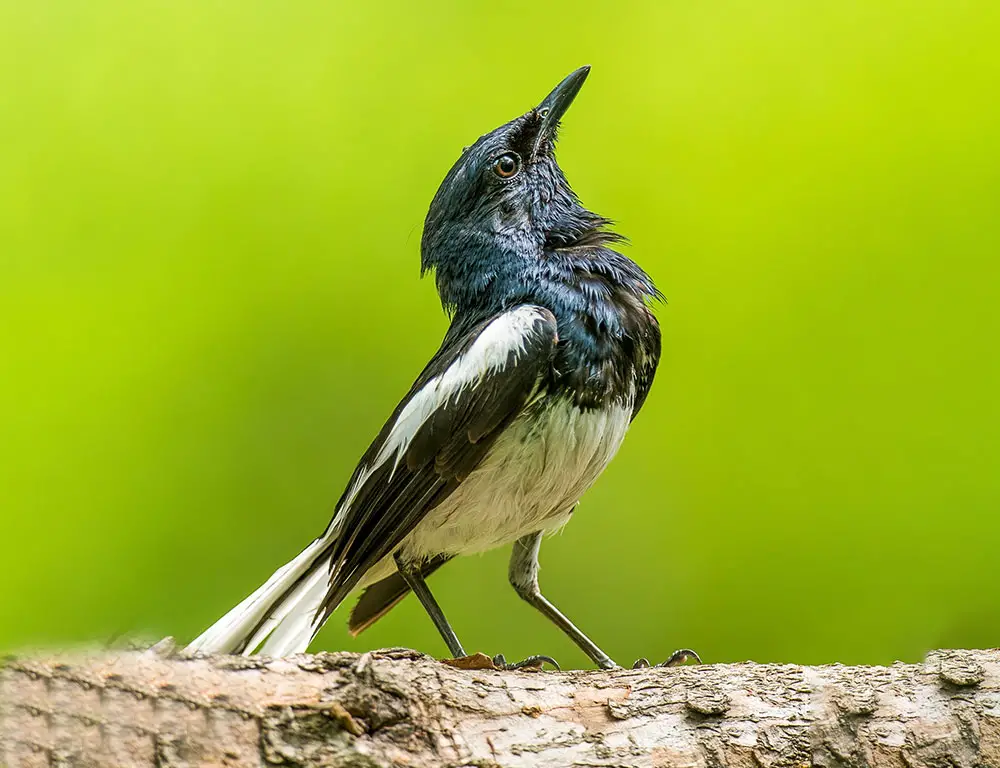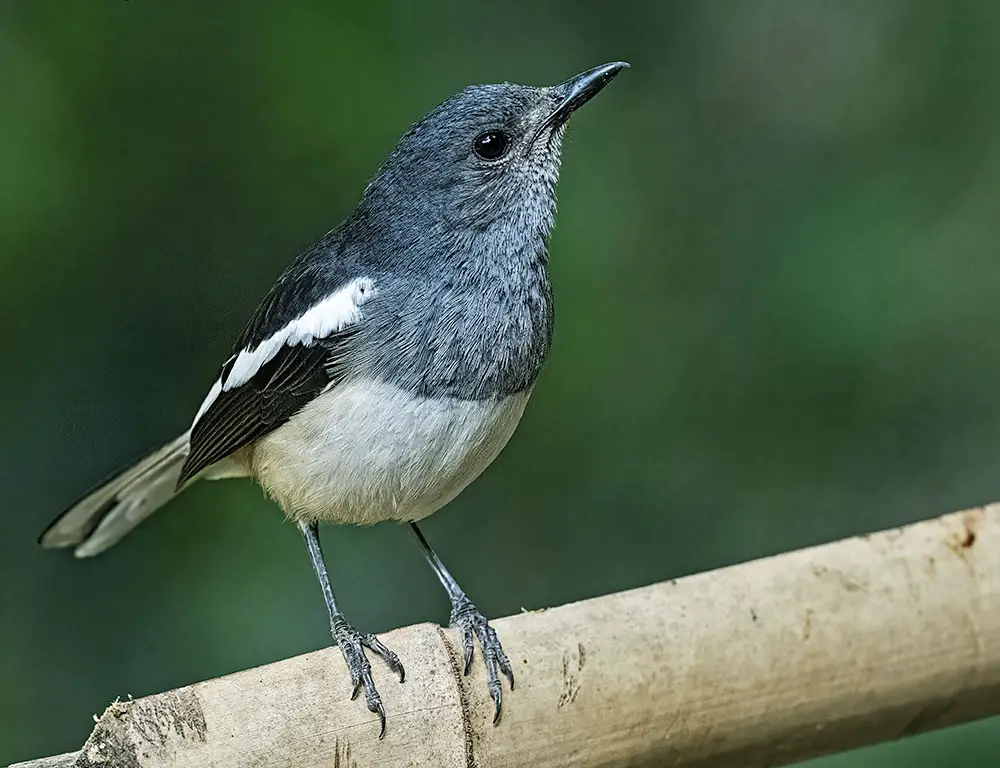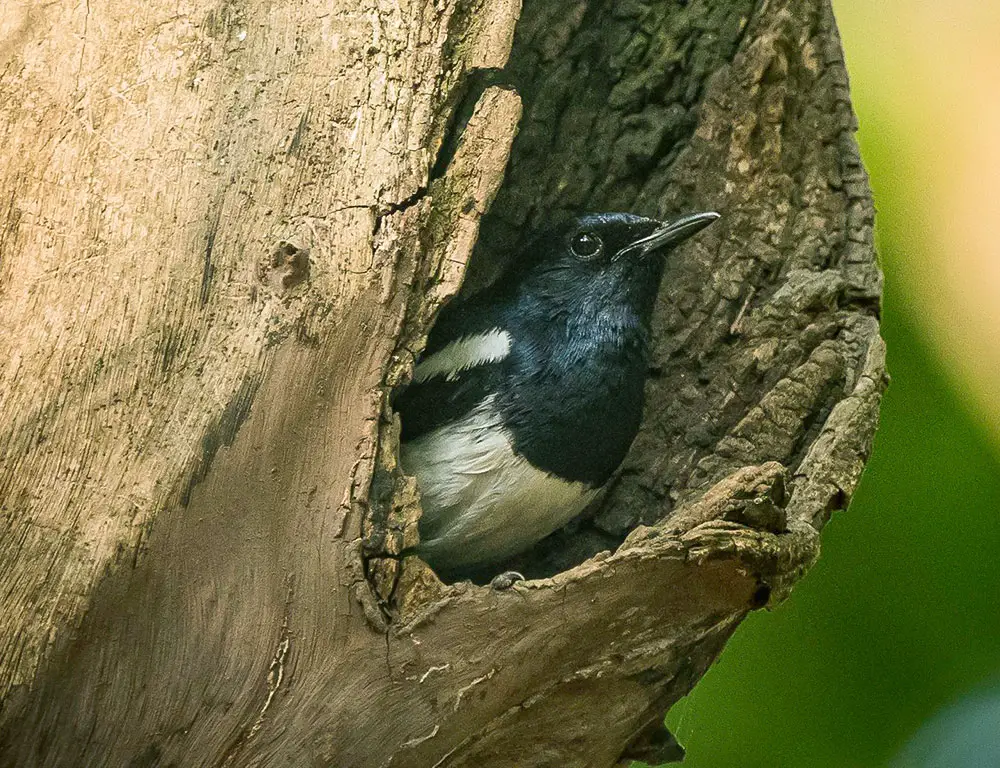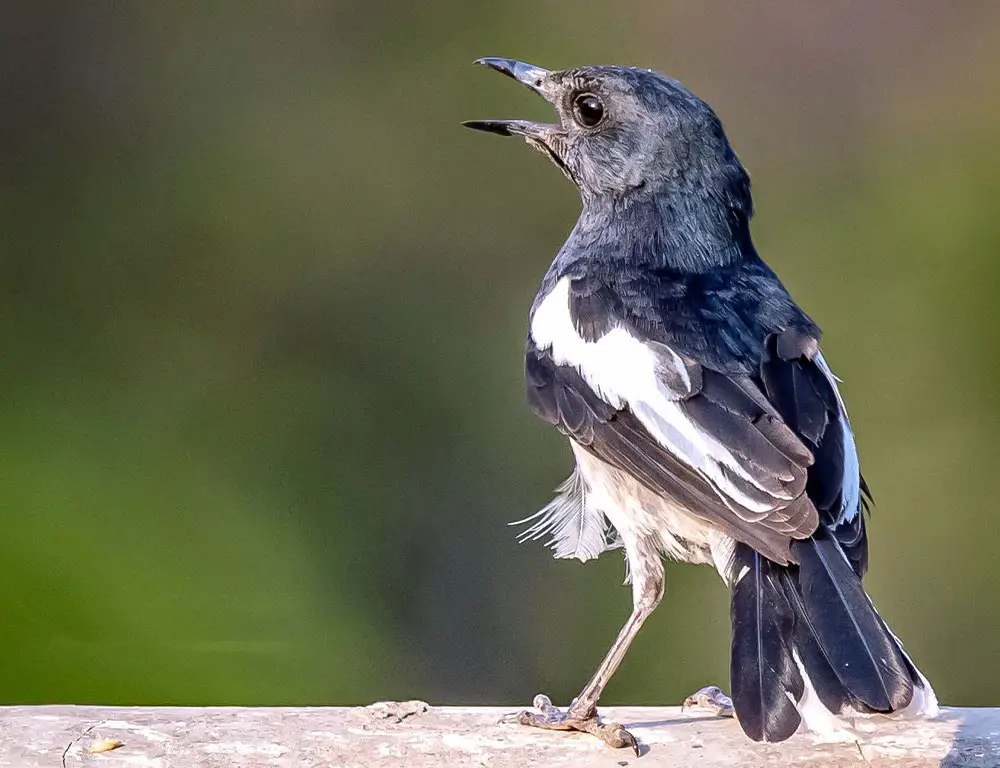The Oriental Magpie-Robin (Copsychus saularis) is a captivating bird species that holds a special place in the hearts of birdwatchers and enthusiasts across its native range in South and Southeast Asia.
Known for its striking black-and-white plumage, melodic songs, and bold demeanor, the Oriental Magpie-Robin captivates observers with its beauty and charisma.
Found in various habitats, from urban parks to dense forests, this avian gem is celebrated for its adaptability and widespread presence in the region.
Let’s delve into the fascinating world of the Oriental Magpie-Robin and uncover its unique characteristics and ecological significance.
Interesting Characteristic Of Oriental Magpie-Robin

The Oriental Magpie-Robin is a widespread and adaptable bird in many parts of Asia. Here is some more information about its distribution, habitat, taxonomy, behavior, ecology, nesting, diet, nutrition, mating habits, and population:
Physical Characteristics
The Oriental Magpie-Robin is a small passerine bird that belongs to the family Muscicapidae. It is widely distributed across South and Southeast Asia, inhabiting various habitats such as forests, gardens, parks, and urban areas. Here are some of the physical characteristics of this beautiful and lyrical bird:
Size and shape
The Oriental Magpie-Robin is about 19 cm long and weighs around 25 g. It has a slender body, a long tail, a short bill, and strong legs. The tail is often held upright or cocked when the bird is perched or foraging.
Color and pattern
The Oriental Magpie-Robin has a striking black and white plumage, with some regional variations. The male has a glossy black head, upperparts, throat, and upper breast, contrasted by a white forehead, supercilium, lower breast, belly, and wing patches.
The female is similar but duller, with a greyish-black head and upperparts and a faint buff wash on the underparts. The juvenile is brownish-grey with streaks and spots.
Sexual dimorphism
The Oriental Magpie-Robin exhibits sexual dimorphism, which means that the male and female have different appearances. As described above, the male is more conspicuous and colorful than the female.
The male also has a longer tail than the female, which may help attract mates and display dominance.
Moult
The Oriental Magpie-Robin undergoes a complete moult once a year, usually after the breeding season. During this time, the bird may look scruffy and lose some of its feathers.
The molt lasts for about two months, and the bird regains its fresh and glossy plumage afterward.
Voice
The Oriental Magpie-Robin is well-known for its rich and varied song, which consists of a series of whistles, trills, and mimicry. The male sings more often and louder than the female, especially during the breeding season and early morning.
The song attracts mates, defends territories, and communicates with other birds. The bird can also produce harsh and alarm calls when threatened or disturbed.
Diet
The Oriental Magpie-Robin is mainly insectivorous, feeding on various insects such as beetles, ants, caterpillars, grasshoppers, and spiders. It also occasionally eats fruits, seeds, nectar, and small vertebrates such as lizards and frogs.
The bird forages on the ground or in low vegetation, often flicking its tail and wings.
Reproduction
The Oriental Magpie-Robin breeds from March to July, depending on the region. The pair forms a monogamous bond and defends a territory. The female builds the nest, usually in a tree hole, an aperture, or a cavity.
The nest is made of grass, leaves, roots, and feathers and lined with finer materials. The female lays 3 to 6 eggs, pale blue or green with brown spots.
The incubation period is about 12 to 14 days, and both parents feed the chicks. The fledging period is about 16 to 18 days, and the young may stay with their parents for some time before dispersing.
Distribution And Habitat

The Oriental Magpie-Robin ranges from Iran and Afghanistan in the west, to China and Japan in the east, and south to Indonesia and the Philippines. It has also been introduced to some islands, such as Mauritius and Singapore.
It occupies various habitats, including forests, woodlands, gardens, parks, plantations, and urban areas. It prefers open or semi-open areas with trees and shrubs and avoids dense or arid regions.
Taxonomy
The Oriental Magpie-Robin belongs to the order Passeriformes, the largest and most diverse group of birds. The table below shows the taxonomic classification of the Oriental Magpie-Robin:
| Taxonomic Level | Classification |
| Kingdom | Animalia |
| Phylum | Chordata |
| Class | Aves |
| Order | Passeriformes |
| Family | Muscicapidae |
| Genus | Copsychus |
| Species | Copsychus saularis |
This table presents the hierarchical classification of the Oriental Magpie-Robin within the broader taxonomy of the animal kingdom, providing insight into its systematic placement among other bird species.
Behavior And Ecology
The Oriental Magpie-Robin is a diurnal and territorial bird active from dawn to dusk. It is usually seen singly or in pairs but may form small flocks outside the breeding season.
A confident and curious bird often approaches humans and other animals. It is also a vocal and musical bird that sings throughout the year, especially in the morning and evening.
It can mimic the sounds of other birds and animals and human noises such as whistles, alarms, and music. It is a resident and sedentary bird which rarely migrates or disperses.
Nesting

The table below shows some of the nesting habits of the Oriental Magpie-Robin:
Table:
| Nesting Habit | Description |
| Location | Typically builds nests in dense vegetation such as shrubs, bushes, or small trees. |
| Nest Structure | Generally cup-shaped, with a shallow depression to hold the eggs and protect the young. |
| Nest Shape | It is positioned within the interior of the vegetation, providing concealment and protection from predators. |
| Nest Placement | Positioned within the interior of the vegetation, providing concealment and protection from predators. |
| Nesting Behavior | Both male and female birds contribute to nest building, with the female primarily responsible for incubating the eggs. |
| Clutch Size | Typically lays 2-5 eggs per clutch, with an incubation period of around 12-14 days. |
This table provides an overview of the nesting habits of the Oriental Magpie-Robin, highlighting key aspects such as location, structure, placement, and behavior during the nesting process.
Diet And Nutrition
The Oriental Magpie-Robin is mainly insectivorous, feeding on insects such as beetles, ants, caterpillars, grasshoppers, and spiders. It also occasionally eats fruits, seeds, nectar, and small vertebrates such as lizards and frogs.
The bird forages on the ground or in low vegetation, often flicking its tail and wings. It needs to drink water regularly and may visit ponds, streams, or puddles to quench its thirst.
Mating Habits
The Oriental Magpie-Robin is a monogamous and territorial bird which mates for life. The pair maintains a close bond throughout the year, engages in courtship, and displays behaviors.
The male sings to attract and impress the female, and may offer her food or gifts such as feathers or flowers. The male also performs a wing-flapping or tail-spreading display, or chases the female in flight.
The female may respond by singing back, accepting the food or gift, or following the male. The pair also preen each other, touch bills, or roost together. The pair copulates several times during the breeding season, usually on a branch or a perch.
Population
The Oriental Magpie-Robin is a widespread bird with an estimated global population of about 100 million individuals. It is not considered threatened or endangered and has a stable or increasing trend.
However, it is vulnerable to habitat loss, degradation, fragmentation, predation, hunting, and trapping. It also faces competition from invasive species such as the Common Myna or the House Sparrow.
It is protected by law in some countries and is appreciated and admired by many people for its beauty and song.
Ranging Map
The Oriental Magpie-Robin is widely distributed, with populations found in India, Bangladesh, Sri Lanka, Nepal, Bhutan, Myanmar, Thailand, Cambodia, Vietnam, Malaysia, Singapore, Indonesia, and the Philippines.
In South Asia, the Oriental Magpie-Robin is commonly found in various habitats, including gardens, parks, forests, and urban areas. It is a familiar sight in cities and towns across India, where it often frequents gardens and open spaces and rural areas with scattered trees and shrubs.
In Southeast Asia, the Oriental Magpie-Robin inhabits a range of ecosystems, from lowland rainforests to montane forests and mangrove swamps.
It can be observed in Thailand, Malaysia, Indonesia, and the Philippines, occupying a similar range of habitats as in South Asia.
Why Is the Magpie The National Bird Of Bangladesh?

The choice of a national bird often reflects a nation’s cultural, ecological, and symbolic values. In the case of Bangladesh, the Magpie Robin (Copsychus saularis) holds significant environmental and cultural importance, making it a fitting choice as the national bird.
Let’s explore seven reasons why the Magpie Robin holds this prestigious title.
Cultural Significance
The Magpie Robin, locally known as “Doyel” or “Dhoyal,” is revered in Bangladeshi culture and folklore. Its melodious songs and striking appearance have inspired poets, musicians, and artists for centuries.
Symbol Of Beauty
With its distinctive black and white plumage and long tail, the Magpie Robin is celebrated for its aesthetic beauty, symbolizing the natural richness and diversity of Bangladesh’s landscapes.
Eco-Tourism Potential
The presence of the Magpie Robin in Bangladesh’s forests and rural areas enhances the country’s eco-tourism potential, attracting birdwatchers and nature enthusiasts from around the world.
Ecosystem Indicator
As an indicator species, the Magpie Robin’s presence in various habitats signifies the health and biodiversity of Bangladesh’s ecosystems, highlighting the need for conservation efforts.
Urban Resilience
The Magpie Robin’s adaptability to urban environments, including parks, gardens, and residential areas, reflects Bangladesh’s resilience in balancing urban development with conservation priorities.
Community Connection
The Magpie Robin’s presence in local communities fosters a sense of connection to nature and encourages environmental stewardship among Bangladesh’s citizens, promoting conservation awareness and action.
National Pride
They designate the Magpie Robin as the national bird, instilling a sense of pride and ownership among Bangladeshis, symbolizing their commitment to preserving the country’s natural heritage for future generations.
The selection of the Magpie Robin as Bangladesh’s national bird symbolizes the country’s rich cultural heritage, ecological diversity, and commitment to conservation.
Its melodious songs and striking beauty resonate deeply with the nation’s identity, making it a beloved national pride and unity emblem.
FAQs
Where can Oriental Magpie-Robins be found?
Oriental Magpie-Robins inhabit a wide range across South and Southeast Asia, including India, Bangladesh, Sri Lanka, Thailand, Malaysia, Indonesia, and the Philippines. They are commonly found in various habitats, including forests, gardens, parks, and urban areas.
What do Oriental Magpie-Robins eat?
Oriental Magpie-Robins primarily feed on insects, spiders, and other small invertebrates, which they forage for on the ground. They also consume fruits and berries, particularly during the breeding season when they may supplement their diet with plant matter.
Are Oriental Magpie-Robins territorial?
Yes, Oriental Magpie-Robins are territorial birds, especially during the breeding season. Males are particularly territorial and will defend their territory from intruders, including other males.
They may engage in aggressive displays and vocalizations to establish and defend their territory.
Do Oriental Magpie-Robins migrate?
Oriental Magpie-Robins are generally non-migratory birds, but some populations may exhibit seasonal movements in response to changes in food availability or environmental conditions.
However, many individuals remain resident in their preferred habitats throughout the year.
Are Oriental Magpie-Robins vocal?
Yes, Oriental Magpie-Robins are known for their melodic songs, which consist of clear whistles, warbles, and trills. Males sing to establish territory and attract mates, while females may also sing softly.
Their vocalizations are often heard throughout their habitats, particularly during breeding.
Conclusion
The Oriental Magpie-Robin stands as a symbol of the rich avian diversity in South and Southeast Asia. With its striking appearance, melodic songs, and adaptability to various habitats, this charismatic bird enchants observers and plays a vital role in maintaining ecosystem balance.
As we continue to appreciate and study the Oriental Magpie-Robin, let us also recognize the importance of conserving its habitats and ensuring its continued presence for future generations to cherish and enjoy.
In protecting this iconic species, we preserve a natural wonder and safeguard a piece of our shared heritage.